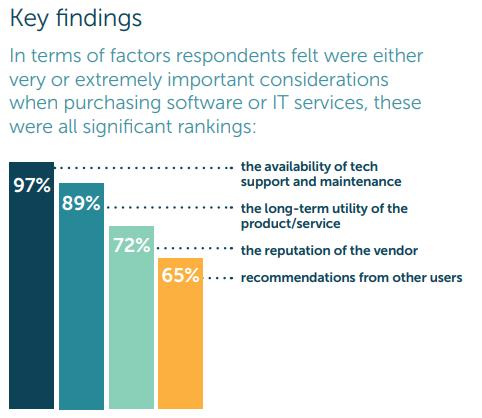In a world that is becoming more and more focused on digital solutions, there has been a push for transforming Australian councils with digital innovation. Unfortunately, government departments, particularly local Government (LGs), are often way off the pace compared to the private sector when it comes to adopting and implementing modern technologies. One of the main reasons for this is budget constraints and staffing.
Members of the community expect to be able to communicate with their council online, rather than having to visit the council customer service centre whenever they have a query, or an issue with a service. Therefore councils need to adopt modern technology that meet community expectations, and do so within a constrained budget and with their existing staff.
This article discusses the challenges faced by Local Governments in delivering enhanced services to their communities, and how many councils have been able to implement outstanding digital customer service, and within budget.
Bridging the technology gap
Communication and service delivery by councils is greatly enhanced with the adoption of the latest digital technologies available. However, lack of funding and skilled staff has impeded the uptake of new technology, creating a technological gap. It’s an even greater struggle for many regional councils, with extremely limited budgets.
According to a survey conducted by KPMG, only 3% of Australian LGs progressed to the actual digital transformation stage. The survey concluded that along with a lack of funding and resources, there is also an insufficient benchmarking process, no clear directions from management, limited knowledge of technology adoption, resistance to change, and the absence of a clear strategy to deliver a seamless digital transformation.
It’s vital to bridge the technology gap in councils. If additional funding isn’t readily available, seeking cost-effective digital solutions is the logical option for getting things up-to-date. To avoid resistance to ways of working, mindsets also need to change. Councils need to recognise and meet the expectations of the community, and develop strategies to achieve this outcome.
Strategic road map for innovation
A clear road map for digital transformation is essential for success in adopting modern technology into LGs. This includes an in depth assessment of team and customer needs, technology options, budgets and solution providers.
It’s necessary to plan for the actual transition process as well. For example, if part of the strategy is to replace a traditional corporate phone system with a cloud based version with contact centre functionality, you’ll need to have a strategy to minimise disruptions for both workers and community members while the transition takes place.
A good strategy is for a task force comprised of management and team representatives to map out a plan for replacing legacy systems with modern, digitised systems that deliver on all the process and budgetary requirements. Liaising with relevant IT specialists will also assist with gaining valuable knowledge on technology capabilities now and in the future, and to understand the options for implementation, training, upgrades, and support – which can differ dramatically between solution providers.
How AI is revolutionising Local Government
With the application of generative AI rapidly rising in many sectors, this technology is also revolutionising Local Government. The outcome is cost reduction, increased efficiency and more humanised digital journeys that feel personable and interactive.
Digital agents and automation
With chatbots rapidly transforming into digital call centre agents, customers expect businesses to use their personal data to offer warm and personalised experiences. With 70% of CX leaders planning to implement generative AI into their touch points over the next few years, it’s vital for chatbots to meet customer expectations and offer a more humanised approach. This includes adopting a tone that aligns with the company’s brand.
In the next two years, CX leaders anticipate that digital agents will be responsible for 57% of chat-based customer support and 53% of email communications with customers. 70% also believe that digital agents are fast becoming highly skilled in personalising customer journeys. With customers now embracing generative AI technology in customer service, BPOs and contact centres of local governments are able to automate many of their services with confidence. Some of the practical applications of digital agents in local government include:
- Personalised services for citizens: Intelligent AI chatbots offer a personalised service, can direct visitors to the right department and answer standard questions.
- Instant licenses and permits: Forget about paperwork nightmares. AI chatbots have the ability to handle everything, saving frustration and valuable time for everyone.
Leveraging big data for real-time analysis and decisions
With 62% of CX leaders feeling they’re behind in offering instant solutions to their customers, there is a lot of pressure on businesses to be able to instantly modify user experiences. Leveraging big data in real-time provides the solution.
Generative AI can analyse mountains of big data in rapid time, delivering just the right information or solution in a matter of seconds. Call centre agents can use predictive agent management tools, powered by AI, to provide these expected real-time results. With this in mind, 79% of CX leaders plan to increase their budgets for agent management tools, while 70% of organisations are actively investing in technology to analyse big data instantly.
Local governments can also use AI and big data to help improve their communities through:
- Intelligent decisions based on data: There’s no need for guesswork when AI can analyse and summarise vast amounts of data in rapid time. This helps management to make informed decisions, and a lot faster.
- Predictive maintenance: AI technology helps avoid unexpected equipment failures by analysing data and anticipate problems before they occur. This helps to minimise downtime.
- Smarter traffic management: AI is capable of real-time data analysis, leading to dynamic signal adjustments and free-flowing traffic.
An essential tool for local councils
In the report – Changing Landscapes: Digital Transformation – What do local councils need in the digital age? compiled in collaboration with the Institute for Public Policy and Governance at the University of Technology Sydney; more than 80% of respondents stated that they wanted the implementation of digital and software solutions to be undertaken by third party providers. The report also states that 87% of respondents would find a web-based service extremely useful. Another point of note is what respondents feel are the most important qualities of IT vendors, as the following graph illustrates.

At Premier Contact Point, our team has extensive experience in helping councils throughout Australia to transition from legacy systems into the digital age and deliver extraordinary customer service to their community.
Our web-based solution is a more cost-effective system than traditional on-premise systems; ideal for local councils constrained by budgets. Being omnichannel, members of the community can contact you by their preferred method, including phone calls, chat, SMS, email, Facebook Messenger and WhatsApp. Other key points include:
- Better service options including easy-to-use self-service workflows.
- Reduced operating costs – your team members only need a computer, internet access and headphones.
- Adaptable and scalable technology to make it easy to cope with peaks and troughs.
Most importantly, we are approved suppliers of contact centre technologies for Australian LGs.
Example outcomes of digital transformation
Premier Contact Point was asked by Tweed Shire Council to upgrade their outdated system. Council was thrilled with the outcome as Contact Point now allows them to deliver exceptional customer service and community support. To further illustrate just what digital transformation means for all councils, here are some of the key outcomes of the project:
- Customer satisfaction scores improved for contact centre staff.
- A reduction in call queue wait times.
- Calls were immediately directed to the right staff member.
- The auto answer feature enabled agents to quickly answer calls and reduce the frequency of abandoned calls in the queue.
- Customer engagement increased.
- A reduction in contact centre costs and complexity.
Start the process for digital transformation
Contact us today for details of the many council digital transformations we’ve been involved in. You may be surprised at the results they’ve been able to achieve.







